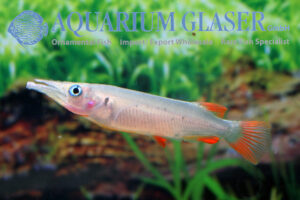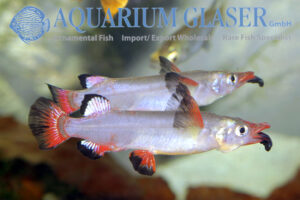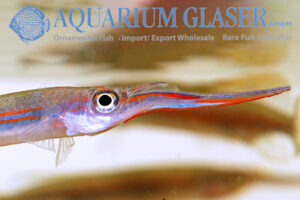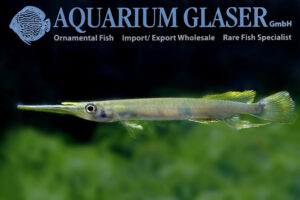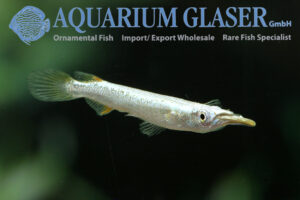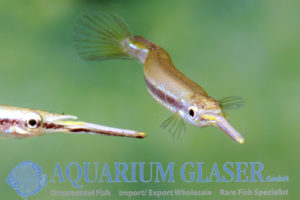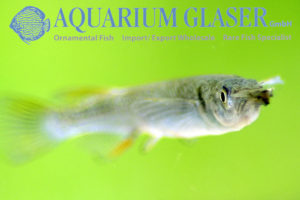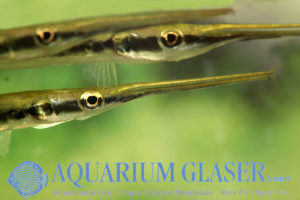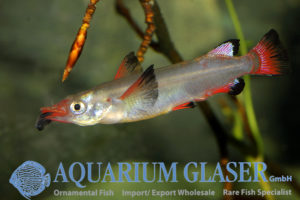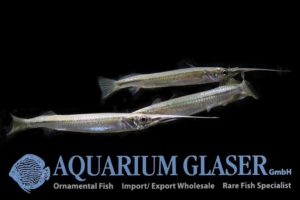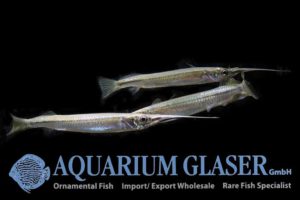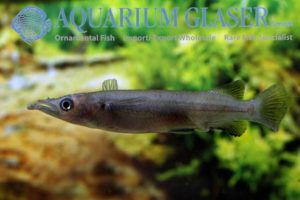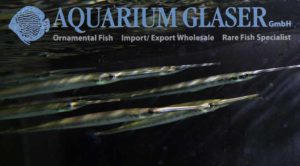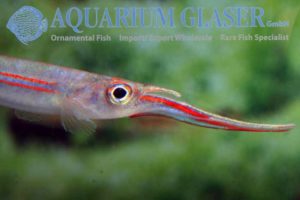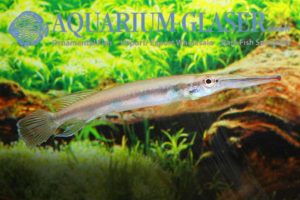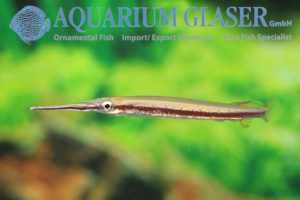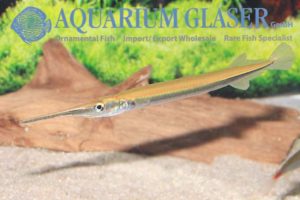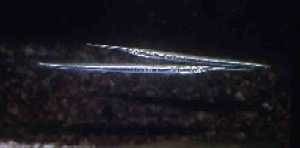We imported very nice specimens of the halfbeak Nomorhamphus ebrardtii. This livebearing fish lives endemic (this means: exclusively there) on the island of Sulawesi, formerly known as Celebes. Here the species occurs mainly in smaller brooks. Maximum length of N. ebrardtii is around 6-7 cm. The bright orange-red fins are very striking as well as […]
19. Halfbeaks (19)
-
-
Nomorhamphus liemi
This beautifully colored halfbeak comes from the island of Sulawesi (= Celebes), where it is found in the south of the island, in the highlands of Maros. In contrast to the closely related genus Dermogenys, the upper and lower jaws are approximately the same length, hence the genus name. For some species, however, it is […]
-
Hemirhamphodon phaiosoma
Once more we could import this very beautiful halfbeak from Indonesia. The halfbeaks of the genus Hemirhamphodon are adapted to blackwater in the wild. Thus they need – at least for the time of acclimatisation – very soft and acidic water. Maximum length of the species is around 6 cm (male), females stay smaller. The […]
-
Hemirhamphodon pogonognathus
Hemirhamphodon are among the most sensitive aquarium fishes. They especially do not tolerate transport well. They come from very soft, acidic water, so called black water. The conditions there are almost hostile to life, which means that there is hardly any bacterial contamination, because even for bacteria the food supply there is too poor. It […]
-
Dermogenys siamensis Silver-White (D. pusillus)
There is a silver-white breeding form of Dermogenys siamensis (in the hobby usually called D. pusillus or D. pusilla, but this is a different species, which is not kept in the aquarium), in which – similar to the gold tetras – shiny color pigment (guanine) is produced in excess in the skin cells. In nature […]
-
Hemirhamphodon tengah
This pretty little fish is a challenge for experienced hobbyists. The species originates from Borneo. In contrast to the widespread prejudice halfbeaks of the genus Hemirhamphodon do not appear in brackish water; they are strictly bound to very soft and acidic water! These fishes are commonly found along with chocolate gouramis and small rasboras. The […]
-
Dermogenys siamensis (D. pusilla)
The systematics of the widespread, small halfbeaks from South and Southeast Asia are complicated. A first revision of the genus by Mohr in 1936 summarized many previously described species under the synonymy of D. pusilla. This was followed by Brembach in 1991; the name D. pusilla was then used in the broadest sense. It was […]
-
Potamorrhaphis labiatus
The slender freshwater needlefish from South America are much sought for by specialists. Many years only one species was mentioned in the aquarium literature, namely Potamorrhaphis guianensis. This species really exists and is said to be fairly wide spread in South America. But it seems that the needlefish we obtain from Peru currently belong to […]
-
Nomorhamphus liemi
This wonderfully coloured halfbeak originates from the island of Sulawesi ( = Celebes) where it occurs in the southern half; it is endemic in the Maros highlands. In contrast to the closely related genus Dermogenys the upper and the lower jaw are approximately equally long (thus the generic name). In some species, however, is seems […]
-
Zenarchopterus dunckeri
The wonderful, large halfbeaks of the genus Zenarchopterus are only very rarely offered, because the animals are very shy during the acclimatisation. When they panic they often hurt themselves seriously. So we are very proud that we were able to import successfully a small group of fully grown specimens of the species Zenarchopterus dunckeri from […]
-
Zenarchopterus dunckeri
There are 20 valid species in the genus Zenarchopterus, all of them occuring along the Pacific coast of tropical Asia. The maximum length of Zenarchopterus is around 15 cm, only a few species are recorded to reach a greater length, most of them stay smaller. The species are very similar to each other and the […]
-
Nomorhamphus celebensis
Most of halfbeaks of the genus Nomorhamphus originate from Sulawesi (formerly known as Celebes). Some species, like N. ebrardtii or N. rex, are traded usually as wild collected ones, others, among them N. liemi, are occasionally also available as bred ones. A species that occurs hardly ever in the trade is the Black Halfbeak, Nomorhamphus […]
-
Potamorrhaphis guianensis
The needlefishes (Belonidae) are mainly marine fish. But there do exist three genera with a total of eight species in South America that live exclusively in freshwater. Among them the genus Potamorrhaphis is the most specious one: currently four acceoted species are known. Potamorrhaphis can attain a maximum length of about 30 cm. Astonishingly these […]
-
Hemirhamphodon phaiosoma
For the first time ever we could import this very beautiful halfbeak from Indonesia. The halfbeaks of the genus Hemirhamphodon are adapted to blackwater in the wild. Thus they need – at least for the time of acclimatisation – very soft and acidic water. Maximum length of the species is around 6 cm (male), females […]
-
Nomorhamphus rex
This species of halfbeak from Sulawesi (formerly: Celebes) has been described scientifically only last year (2012). It can be distinguished most easily by the coloration from N. ebrardtii, a quite similar species (see http://www.aquariumglaser.de/en/nomorhamphus-ebrardtii_de_1519.html). N. rex has yellow ventral fins, N. ebrardtii reddish-orange ones, N. rex has a red lower beak, the lower beak of […]
-
Hemirhamphodon kuekenthali
Gorgeous, large specimens of this livebearing halfbeak reached us from Borneo (Sarawak) recently. The species can hardly be told apart from the better known relative, H. pogonognathus. However, we have the feeling that it is a bit stouter. But our determination bases mainly on the origin (Sarawak). Like all other Hemirhamphodon, H. kuekenthali is a […]
-
Hemirhamphodon tengah
This pretty little fish is a challenge for experienced hobbyists. The species originates from Borneo. In contrast to the widespread prejudice halfbeaks of the genus Hemirhamphodon do not appear in brackish water; they are strictly bound to very soft and acidic water! These fishes are commonly found along with chocolate gouramis and small rasboras. The […]
-
Xenentodon canciloides
The Needlefishes (Belonidae) are a relative small family and are represented by a small number (about 35) of species only, but these are very successful and can be found in marine and freshwater habitats of temperate and tropical regions worldwide. Some of them are so common that they form the basis of a commercial fishery […]
-
Potamorrhaphis guianensis
These fish belonging to needlefish (Belonidae) reach the aquariums of interested hobbyists only very seldom. These robbers, called halfbeak, come from almost all over Amazonia. You can find them also in the Orinoco catchment area as well as in the Guyana countries. These specialized surface fish are only suitable for the the hobbyists with restrictions […]





